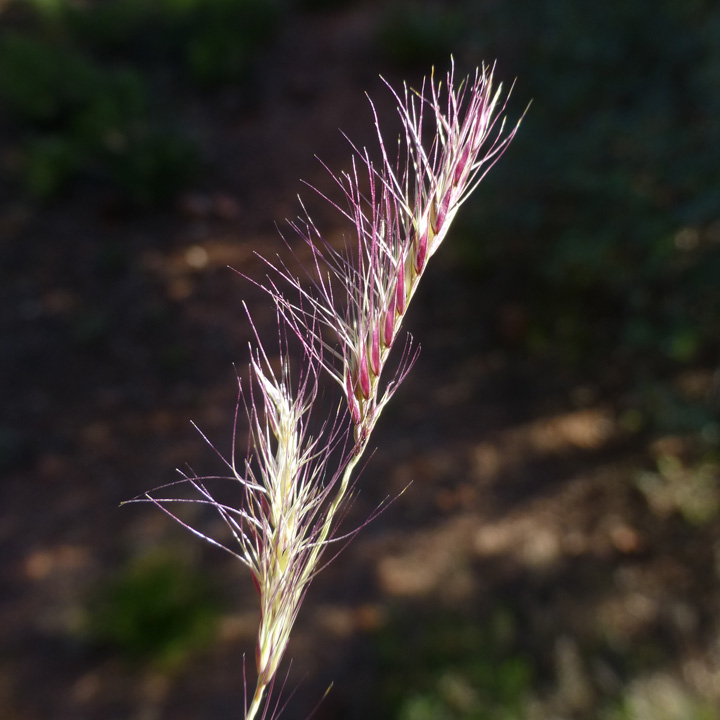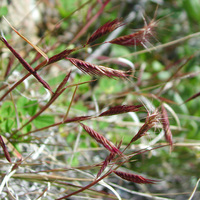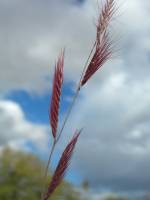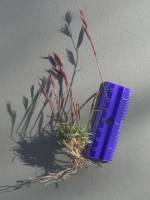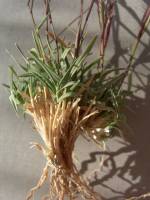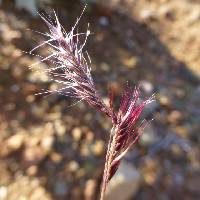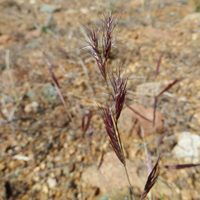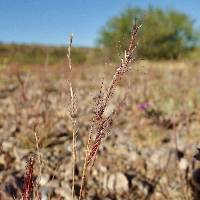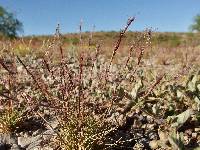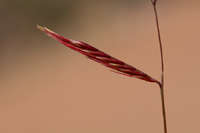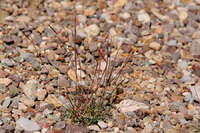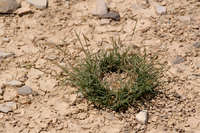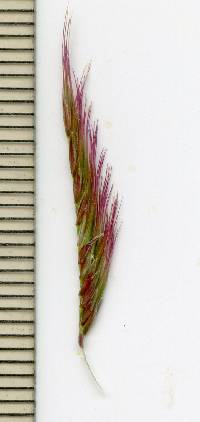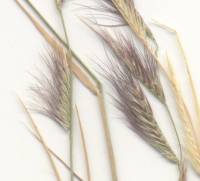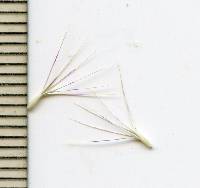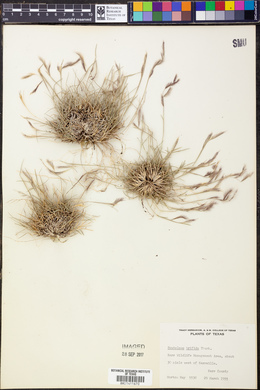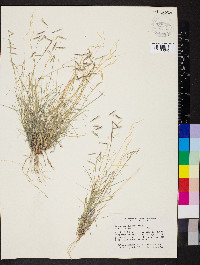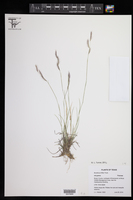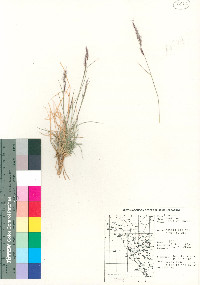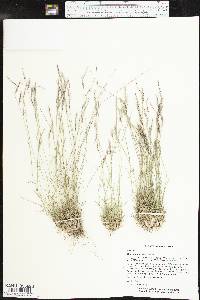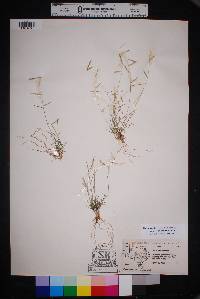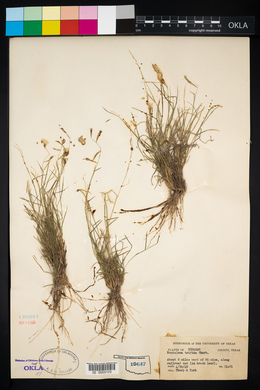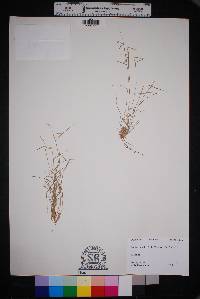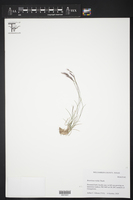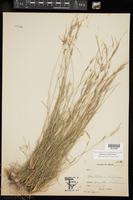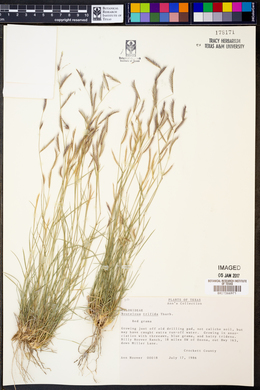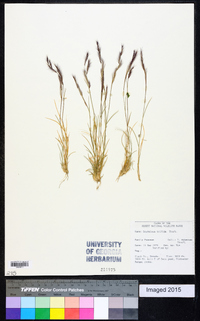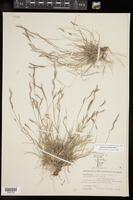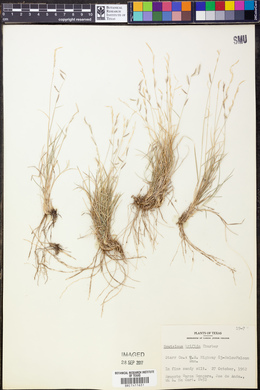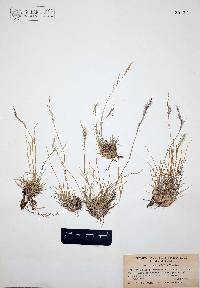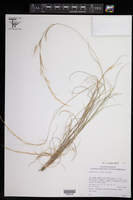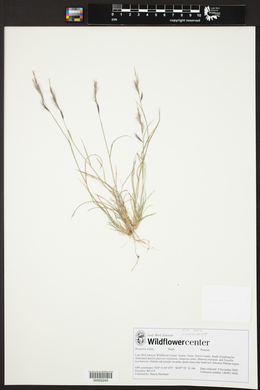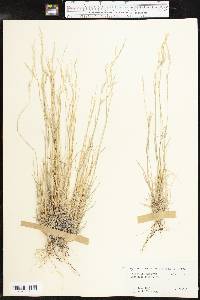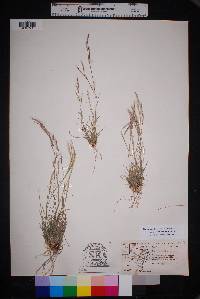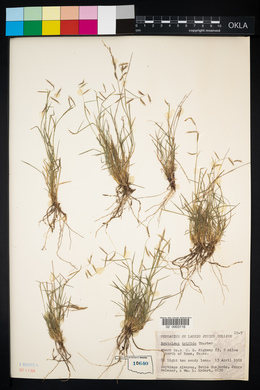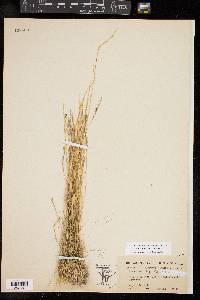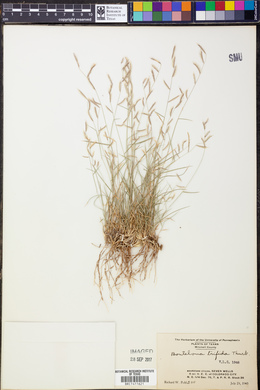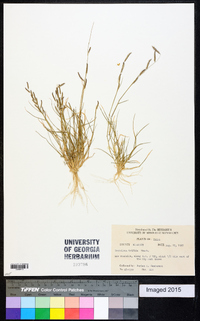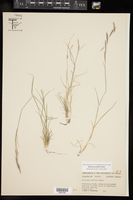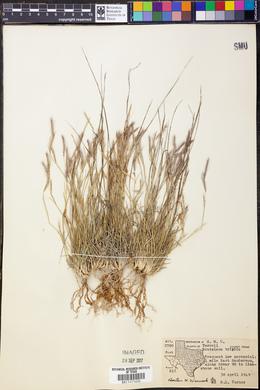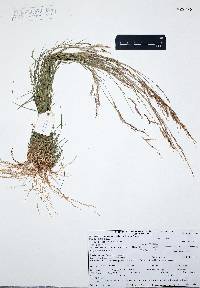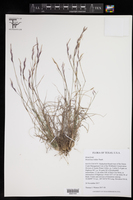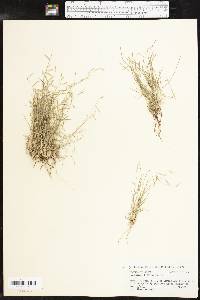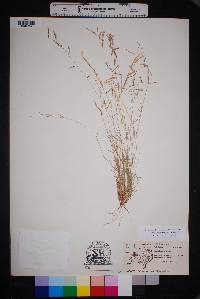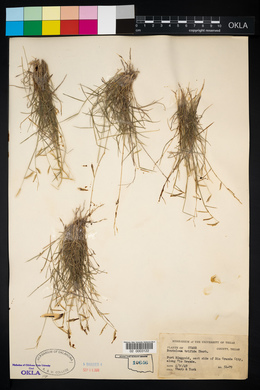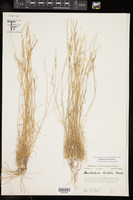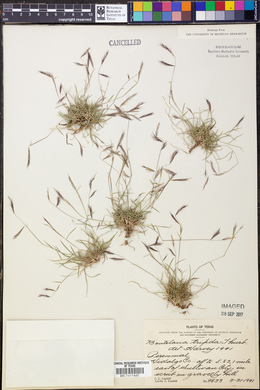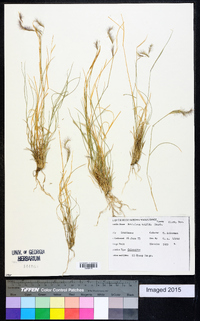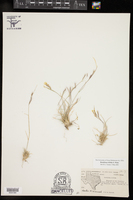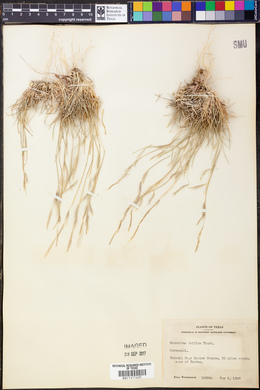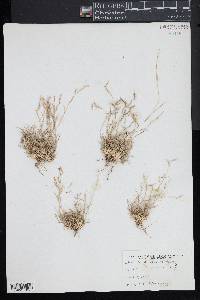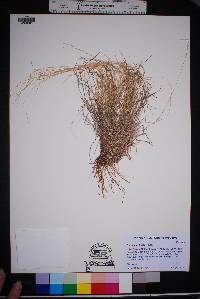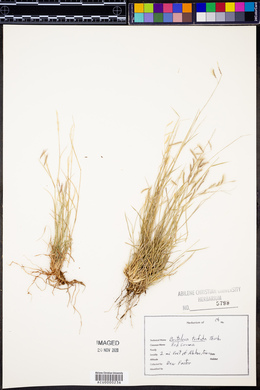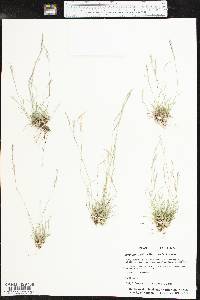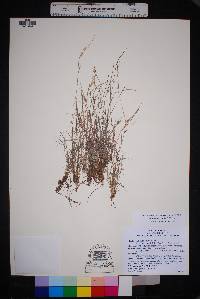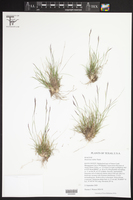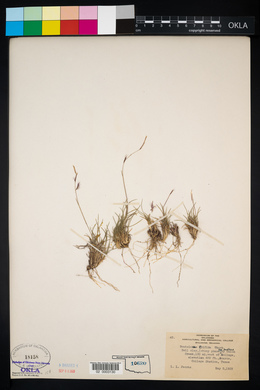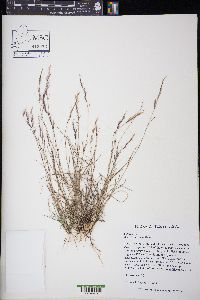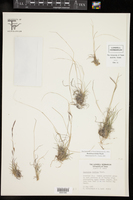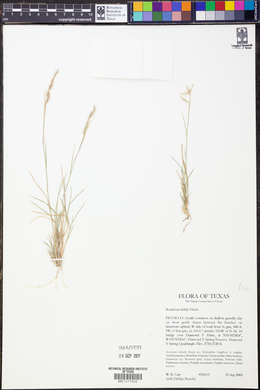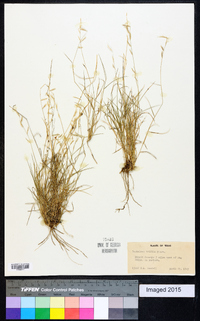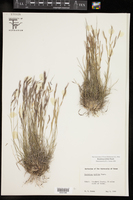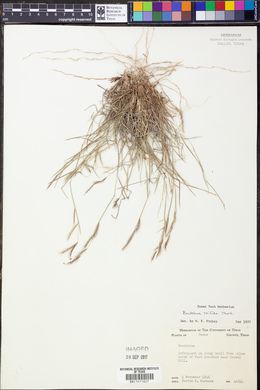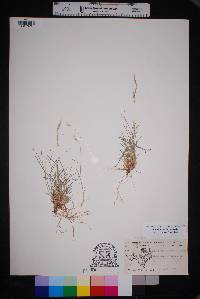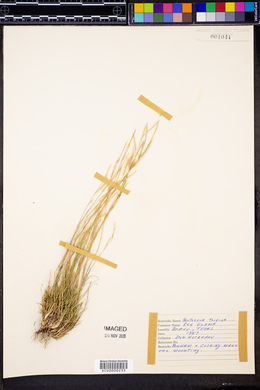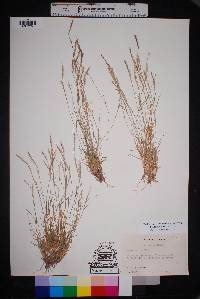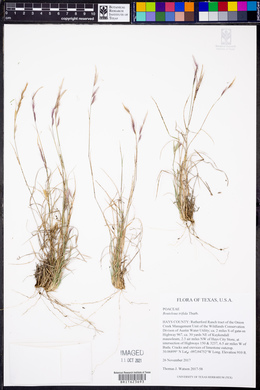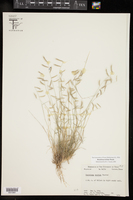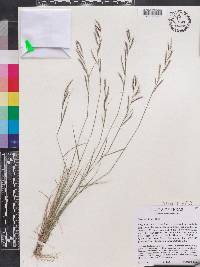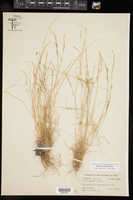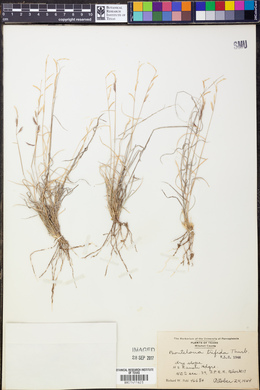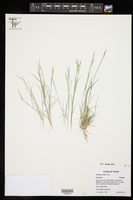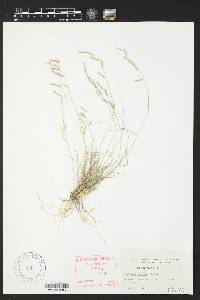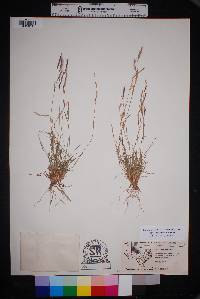Bouteloua trifida
|
|
|
|
Family: Poaceae
Red Grama, more...red gamma (es: navajita roja, navajita china)
[Bouteloua burkii Scribn., moreBouteloua trinii (E. Fourn.) Griffiths, Chondrosum trifidum (Thurb.) Clayton, Chondrosum trifidum var. trifidum , Chondrosum virletii E. Fourn.] |
Plants perennial; cespitose, older plants occasionally shortly rhizomatous. Culms 5-40 cm, slender, wiry, erect or slightly geniculate at the lower nodes; lower internodes glabrous, shorter than those above. Leaves mostly basal; sheaths glabrous, sometimes scabridulous, becoming flattened, persistent; ligules 0.2-0.5 mm, of hairs; blades 0.7-8 cm long, 0.5-1.5(2) mm wide, scabridulous, margins often with papillose-based hairs basally. Panicles 3-9 cm, with 2-7 branches; branches 7-25 mm, persistent, spreading, ascending, or appressed, straight to slightly arcuate, with 8-24(32) spikelets, axes terminating in a spikelet; disarticulation above the glumes. Spikelets appressed to pectinate, reddish-purple; with 1 bisexual floret and 1 rudimentary floret. Glumes bilobed; lower glumes 1.7-3.4 mm, slightly shorter than the upper glumes, veins excurrent to 0.6 mm; upper glumes 1.9-4 mm, glabrous or pubescent, hairs not papillose-based, veins excurrent to 1 mm; lower lemmas 1.2-2.2 mm, glabrous, sparsely appressed pubescentalong the veins or densely appressed pubescent for much of their length and on the margins, trilobed, lobes veined, tapering into 3 awns, awns 2.2-6.6 mm, central awns not flanked by membranous lobes; anthers 0.2-0.4 mm, yellow; rachilla internodes glabrous; upper florets glabrous, of 3-awned, awns equal, 2-7 mm. Caryopses 0.8-1.5 mm long, 0.3-0.6 mm wide. 2n = 20. Bouteloua trifida grows on dry open plains, shrubby hills, and rocky slopes, at 2200-2500 m. Its range extends from the southwestern United States to central Mexico. It is a drought-resistant species that is sometimes mistaken for Aristida because of its delicate, cespitose growth habit and purplish, 3-awned spikelets. Juvenile plants may also be confused with B. barbata, but that species is annual, with the central awn flanked by two membranous lobes and the lowest paleas 4-lobed and 2-awned. Dr. David Bogler, USDA NRCS PLANTS Database Perennials, Terrestrial, not aquatic, Rhizomes present, Rhizome short and compact, stems close, Stems nodes swollen or brittle, Stems erect or ascending, Stems geniculate, decumbent, or lax, sometimes rooting at nodes, Stems caespitose, tufted, or clustered, Stems terete, round in cross section, or polygonal, Stem internodes hollow, Stems with inflorescence less than 1 m tall, Stems, culms, or scapes exceeding basal leaves, Leaves mostly basal, below middle o f stem, Leaves conspicuously 2-ranked, distichous, Leaves sheathing at base, Leaf sheath mostly open, or loose, Leaf sheath smooth, glabrous, Leaf sheath hairy at summit, throat, or collar, Leaf sheath and blade differentiated, Leaf blades linear, Leaf blades very narrow or filiform, less than 2 mm wide, Leaf blades mostly flat, Leaf blade margins folded, involute, or conduplicate, Leaf blades mostly glabrous, Leaf blades more or less hairy, Leaf blades scabrous, roughened, or wrinkled, Ligule present, Ligule a fringe of hairs, Inflorescence terminal, Inflorescence with 2 or more spikes, fascicles, glomerules, heads, or clusters per culm, Inflorescence a panicle with narrowly racemose or spicate branches, Inflorescence with 2-10 branches, Inflorescence branches 1-sided, Inflorescence branches terminating in bristle or point, Flowers bisexual, Spikelets sessile or subsessile, Spikelets laterally compressed, Spikelet less than 3 mm wide, Spikelets with 1 fertile floret, Spikel ets solitary at rachis nodes, Spikelets all alike and fertille, Spikelets bisexual, Spikelets disarticulating above the glumes, glumes persistent, Spikelets secund, in rows on one side of rachis, Rachilla or pedicel glabrous, Glumes present, empty bracts, Glumes 2 clearly present, Glumes equal or subequal, Glumes distinctly unequal, Glumes equal to or longer than adjacent lemma, Glume equal to or longer than spikelet, Glumes 1 nerved, Lemma coriaceous, firmer or thicker in texture than the glumes, Lemma 3 nerved, Lemma glabrous, Lemma apex dentate, 3-5 fid, Lemma distinctly awned, more than 2-3 mm, Lemma with 3 awns, Lemma awn less than 1 cm long, Lemma margins thin, lying flat, Lemma straight, Palea present, well developed, Palea membranous, hyaline, Palea shorter than lemma, Palea 2 nerved or 2 keeled, Stamens 3, Styles 2-fid, deeply 2-branched, Stigmas 2, Fruit - caryopsis, Caryopsis ellipsoid, longitudinally grooved, hilum long-linear.
FNA 2003, Gould 1980 Common Name: red grama Duration: Perennial Nativity: Native Lifeform: Graminoid General: Cespitose perennial grass, 5-40 cm tall; stems slender, wiry, erect; older plants occasionally shortly rhizomatous. Vegetative: Sheaths glabrous, sometimes minutely roughened, persistent, becoming flattened; blades mostly in a basal clump, 1-8 cm long by 1 mm wide, minutely roughened, flat to loosely infolded, often with papillose-based hairs on the margins near the base; ligules Inflorescence: Panicle 3-9 cm long with 2-7 persistent spicate branches per stem; branches 7-25 mm long, spreading, ascending or appressed, straight to slightly arching, with 8-24 spikelets, the branch axis terminating in a spikelet; spikelets appressed to pectinate, reddish-purple, each with 1 bisexual and 1 rudimentary floret; glumes subequal, mucronate from slightly bifid apexes, the lower glume 1.5-3.5 mm, the upper glume slightly longer; lemma 1-2.5 mm, sparsely appressed-pubescent along veins, tapering into 3 awns; lemma awns 2-6.5 mm long; spikelets disarticulating above the glumes. Ecology: Found on dry open plains and rocky slopes from 2,000-5,000 ft (610-1524 m); flowers March-June. Distribution: s CA and s NV, east to TX; south to n MEX. Notes: Distinctive among the Bouteloua with its purplish 3-awned lemmas; the spikelets are usually pectinate (arranged like the teeth of a comb) in classic Bouteloua fashion, but can appear appressed instead making it resemble an Aristida; additionally, young plants can look similar to the small annual Bouteloua barbata. There is a single variety in Arizona: var. trifida. This variety is found throughout the species- range and is distinguished by its lower lemmas being glabrous or sparsely appressed-pubescent on both sides of the veins, with awns 4-6.6 mm long and anthers 0.3-0.4 mm long. Var. burkii, found only in s NM, s TX, and adjacent MEX, has densely appressed-pubescent lower lemmas and shorter awns, 2-4.5 mm long. Ethnobotany: Unknown, but other species in the genus have many uses. Etymology: Bouteloua named for brothers Claudio (1774-1842) and Esteban (1776-1813) Boutelou Agraz, Spanish botanists and horticulturalists; trifida means cleft into three parts, referring to the 3-awned lemmas. Synonyms: None Editor: SBuckley 2010, AHazelton 2015 |
|
|
|

